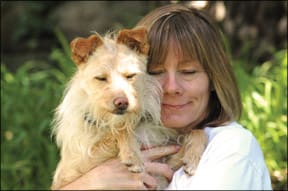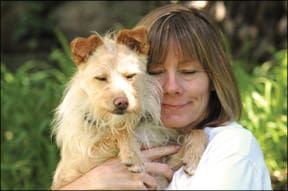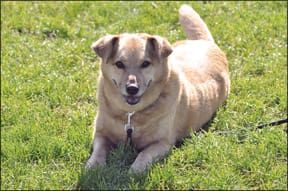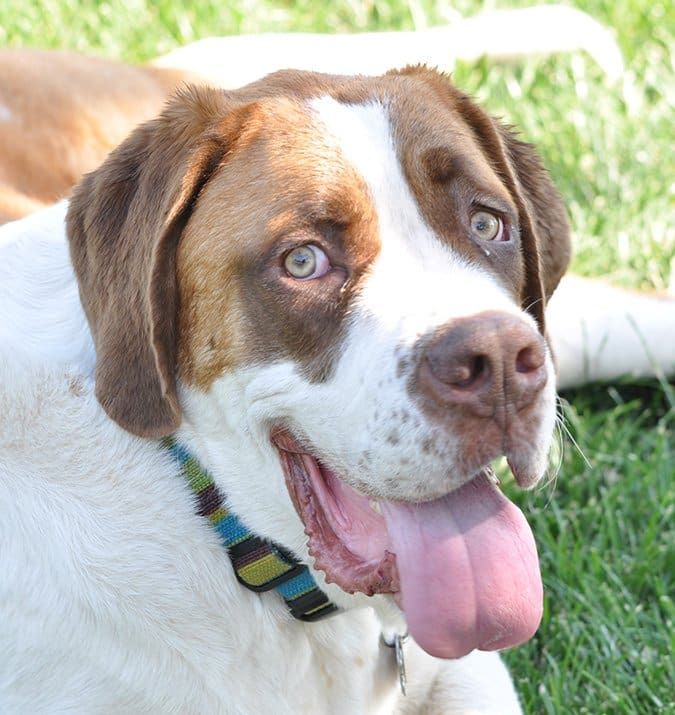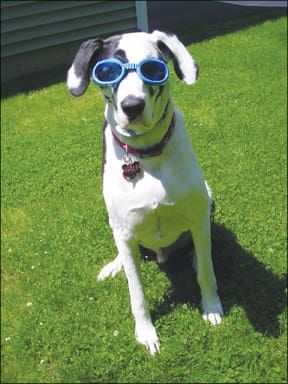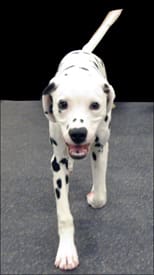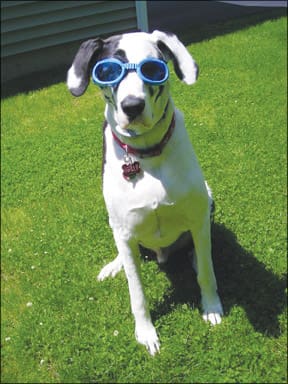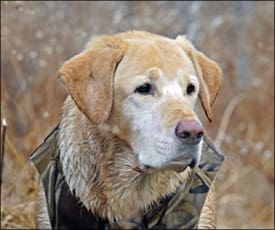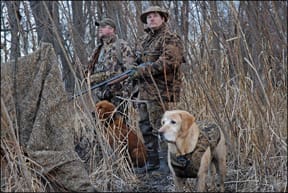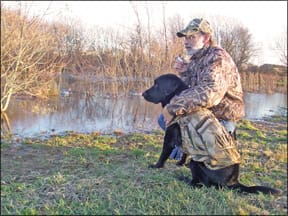Grain-free dry dog food has become wildly popular in the past few years. More and more companies are rolling out a grain-free kibble, as demand for this type of food keeps growing. Why are they so popular?
We’ve found that many dog owners who feed grain-free foods don’t know why they are spending a small fortune on these foods. Or, we should say, they often have their reason, but only rarely are the reasons valid!
As the most common example, some people say they’ve switched to grain-free foods “because dogs don’t need carbs.” Well, they are partly right; dogs don’t require carbohydrates in their diet. But grain-free dry dog foods do contain carbs! In fact, many grain-free foods contain a fair amount of carbohydrates in the form of potatoes, sweet potatoes, tapioca, or peas.
Grain-free foods perform really well when fed to some dogs, but may be inappropriate for others, for example, when a high-fat or high-protein diet is contraindicated. Dogster.com explains the different kinds of grains in relation to dogs’ diets here.
Our philosophy is this: owners should feed their dogs the diets that work best for their individual animals, and develop an accurate understanding of why those diets work well. In an effort to support that suggestion, let’s look at grain, carbs, and how these can be used (or not!) to best meet the nutritional needs of your dog.
What are Carbs?
Carbohydrates are used by dogs as a source of glucose. As such, carbs provide energy, a source of heat when metabolized, and products that can be used as building blocks for other nutrients.
Carbohydrates can be divided into two categories: simple and complex.
Simple carbohydrates, such as fructose, sucrose, and lactose, require little or no digestive breakdown and are readily absorbed from the small intestine and converted into glucose. These are found in table sugar, honey, and fruits, as just a few examples.
Complex carbohydrates are further categorized as either starches or fibers, and are digested more slowly than simple carbohydrates. Starches require additional breakdown by enzymes, produced by the pancreas and intestinal wall, before they are absorbed and utilized by the dog. Starches are contained in grains; vegetables such as potatoes and peas; and beans.
Fiber is resistant to enzymatic digestion; some fibers are fermented by intestinal microbes. Dietary fiber is found only in plant foods: fruits, vegetables, nuts, and grains, and comes from the portion of plants that is not digested by enzymes in the intestinal tract.
The glycemic index (GI) – the rate at which carbohydrates are absorbed into the bloodstream – is, in general, lower for foods containing complex carbohydrates than simple carbohydrates, but there are exceptions. A number of factors influence a food’s GI, including processing, type of starch, fiber content, ripeness (of fruit), fat or acid content, preparation, and how each individual’s body processes food, including how much the food is chewed, and how quickly it is swallowed. For example, foods such as carrots, bananas, watermelon, and whole wheat bread might have a high GI, but contain relatively little carbohydrate, with the end result being they have little effect on blood sugar levels.
Common carbohydrate sources used in canine diets include grains, fruits, vegetables, and a few other interesting foodstuffs.
“Whole” grains, which contain the entire grain kernel (the bran, germ, and endosperm), are good quality carb sources. Examples include whole wheat, bulgur, oatmeal, corn/cornmeal, brown rice, buckwheat, barley, rye, amaranth, millet, quinoa, and triticale.
When you find these ingredients in a kibble (or canned food), they will be cooked and therefore readily digestible. For home-prepared diets, it’s essential to cook these grains well, often soaking overnight, to increase digestibility. Whole grains pack a pretty powerful wallop in terms of good stuff such as dietary fiber, B vitamins, and important minerals such as iron, selenium, and magnesium.
Of lesser value are “refined” grains, which have been milled, a process that removes the bran and germ. Milling also removes dietary fiber, iron, and many B vitamins, so refined grains provide little nutrition but still contain the same number of calories. The dog’s body processes refined grains quickly, resulting in a more immediate impact on blood glucose levels. Examples of refined grain products are white flour, degermed cornmeal, white rice, and pasta (semolina).
There might be medical reasons to feed refined grains to a dog (due to their ease of digestibility), but our preference for healthy dogs is to stay away from refined products, particularly in significant quantities. Vegetables and fruits are also common sources of carbohydrates. Tapioca, potatoes, sweet potatoes, and taro, among others, contain starch, and are typically higher in carbohydrate, but are also healthful sources of calories in moderation. When feeding those kinds of vegetables in a home-prepared diet for your dog, you’ll want to cook them. To help with digestibility, most other vegetables should either be cooked or if served raw, finely ground. Fruits and vegetables are a fabulous source of naturally occurring antioxidants.
Other good-quality carbohydrate-containing foods include legumes (beans), dairy products (e.g., milk, cheese, cream cheese, cottage cheese, ricotta cheese, yogurt), some organ meats, oysters, and mussels.
Then there are the “empty” carbs – ingredients that offer little or no nutrition for the dog, but provide some other service. Fiber helps regulate the transit time of the bowel contents and form of the stool. Common sources of this type of fiber include soybean hulls; wheat, rice, or oat bran; beet pulp; and pea fiber.
Why Should Dogs Eat Carbs?
As we mentioned before, dogs have no nutritional requirement for dietary carbohydrates. They can get everything they need from a diet that contains only protein and fat. Energy metabolism in the dog can be based on fat oxidation and the breakdown of protein to produce glucose.
There are two main reasons why we feed carbs to dogs. The first reason is because we can. Dogs can utilize just about anything we feed them; their digestive tracts are extremely versatile. The second reason is economic; fat and protein sources are much more expensive than carbohydrates.
People often point fingers at the pet food industry, accusing it of using grains to nutritionally short-change our pets in favor of profits. But humans have fed grains and other carbohydrate sources to their dogs as long as we’ve had leftovers. Animal protein and fat has always been at a premium! And our dogs have always gotten only as much of the meat (and bones, fat, hooves, connective tissue, and organs) as we felt we could spare.
Also, it’s obviously quite possible to make adequate diets for dogs that are quite high in inexpensive grains – the majority of the global pet food industry is devoted to this very endeavor. If these foods were as nutritionally inadequate as many industry critics make them out to be, we wouldn’t have a pet overpopulation problem, if you know what we mean! Many carbs contain a slew of vitamins, phytochemicals, minerals, trace elements, dietary fiber, and even some fatty acids and protein. And many dogs do just fine on these diets.
Structurally, carbohydrates (starches in particular) are essential to dry pet food processing; commercial extruded pet foods use starches to give the food structure and texture. Even some canned dog foods contain a carbohydrate source. Gums and gelling agents are often used to solidify canned food and absorb water in high-moisture foods to eliminate “free” water in the container. Guar gum is one agent used that is derived from the ground endosperm of the guar plant; it is used as an emulsifier, thickener, and stabilizer in canned foods.
In addition to keeping kibble together, carbohydrate-rich ingredients are included in many commercial dog foods because of their relatively low cost, caloric contribution (4 calories/gram) and ease of sourcing. This helps keep the price of the food attractive to cost-conscious dog owners.
Bargain hunters aren’t the only ones whose dogs can benefit from diets that contain carbs. According to Susan G. Wynn, DVM, CVA, CVCH, AHG, “While dogs do not require the carbohydrates found in grains or potatoes or any other food, there are some instances where a dog still might derive benefit from them being there.”
Dr. Wynn recently completed a residency in nutrition at the University of Tennessee’s College of Veterinary Medicine, and in addition to private practice, lectures internationally on the topic of clinical nutrition and holistic medicine. She is also a fan of properly formulated carb- and/or grain-containing diets for dogs – except when contraindicated by an individual dog’s medical needs – because both carbs and grains offer certain benefits.
“For instance,” she says, “grains contain certain fibers that are beneficial for the growth of probiotic bacteria in the gut, and they also contain various required vitamins and minerals.”
Dr. Wynn also points out that grains, which have a lower fat content than meat, can be used in some cases as a “place-holder” in a home-prepared diet to help fill up a dog whose weight needs better control.
Sorting Out Carbohydrate Facts From Fiction
Misconceptions abound regarding carbohydrate-containing foods, especially grains, in the canine diet. Dr. Wynn addresses a few of these in her “Pet Health and Nutrition” blog, which we’ve borrowed from here:
“Dogs have a shorter GI tract than people, so they can’t digest grains unless they are partially digested first.”
Fact: Decades of research have proven that dogs digest grains and carbohydrates quite well. More specifically, Dr. Wynn points out that although dogs lack salivary amylase, they
tend not to chew their food; they’re gulpers, so why would they benefit from an oral digestive enzyme? She explains that dogs, like humans, manufacture potent pancreatic amylase and “brush border” enzymes to digest carbs, with most digestion occurring in the first part of the small intestine.
There’s also a belief that a dog’s stomach is acidic and that dogs retain food in their stomachs longer than people, so a meat based diet is more appropriate (protein is initially digested in the stomach). Dr. Wynn points out that the pH range of the dog’s stomach is quite similar to that of humans: it ranges from 1.08 to 5.5 in dogs, and in humans, from 1.0 to 4.0. The main difference is that the dog is actually more alkaline at times. It’s true, she says, that dogs can’t digest cellulose – a single structural carbohydrate used by plants to form things like stalks, seed coats, and vegetable structure – but neither can humans (only some herbivores, such as cows, can). This is why to derive the most benefit from grains and vegetables, we cook or finely grind them first.
“Feeding carbohydrates places stress on the pancreas.”
Fact: The job of the pancreas is to produce enzymes to digest fats, proteins, and starches. During pancreatic inflammation (e.g., pancreatitis), those enzymes are released and cause inflammation and damage to the pancreas and surrounding organs and tissues. To suppress production of the enzymes, veterinarians suggest that you reduce the fat in the dog’s diet and feed a diet that is high in carbohydrates. Dr. Wynn cautions
that casually feeding digestive enzymes daily as a supplement can downregulate the pancreas’ own production of proteases — not necessarily a good thing.
“Grains cause allergies.”
Fact: Dogs can become allergic to certain foods if they have the genetic predisposition to develop food allergies. In a review of seven studies, Dr. Wynn found that dogs are most
commonly allergic to the following foods (in descending order): beef, dairy, wheat, egg, chicken, lamb/mutton, soy, pork, rabbit, and fish. In her personal experience she has seen higher numbers of corn allergy but emphasizes that grains do not constitute the majority of allergy offenders.
Too Much?
Note that some pet food companies take this approach to an extreme, formulating foods that contain more than 50 percent carbohydrates (and low-quality sources at that!). These foods may also contain 15 percent (or more) crude fiber.
According to Small Animal Clinical Nutrition (published by Mark Morris Institute and often considered the bible of pet nutrition), “a small amount of fiber (less than 5 percent) that contains both rapidly and slowly fermentable fibers is recommended in foods for healthy pets.” The text goes on to say that, “Excess fiber may have undesirable effects. For instance, certain fiber types decrease mineral absorption. The effects on mineral absorption vary by type of fiber and the mineral. More rapidly fermentable fibers (e.g., pectins and guar gum) appear to decrease availability of some minerals, whereas fibers that contain more cellulose have little effect on mineral absorption.
“Excess fiber can dilute the energy and nutrient content of the food to such an extent that an animal may have difficulty eating enough of the food to meet its needs.”
How can you tell whether a food contains “too much” total carbohydrate? For that matter, how can you tell at all how much carbohydrate a food contains? The guaranteed minimum percentages of protein and fat, and the maximum percentages of fiber and moisture, are required by law to appear on a pet food label. But only particularly interested owners are apt to learn the approximate carb content of a food; you’d have to either call the pet food maker and ask for this information, or do some math.
To roughly calculate the percentage of carbohydrate in a food, look at the guaranteed analysis on the label, and subtract the amount of protein, fat, moisture, and ash from 100 percent; the carb content is what’s left over. (You may have to contact the company to get the food’s ash content; it’s not required on the label, either.)
“Ideal” Carbohydrate Amounts Vary by Dog
Ultimately, it will be up to your dog – and your observation skills – to determine what constitutes “too much” and “too little” carbohydrate in his diet; there is no such thing as an “ideal” percentage of carbs in a canine diet. It totally depends on the dog, say Sean Delaney, DVM, MS, DACVN, and Sally Perea, DVM, MS, DACVN, veterinary nutritionists with Natura Pet Products. Drs. Delaney and Perea agree that some dogs do well on lower carbohydrate foods and others do not; it depends on the individual
Dr. Wynn adds, “Different dogs digest grains in different ways. Some dogs have excellent stool quality when there are grains in the diet, and others don’t. As a species, the domestic dog does not have a single, consistent nutrient profile requirement.”
Given that there is no commonly accepted ideal for the carb content of canine diets, there aren’t standards for what is considered low, moderate, or high carb levels, either. Drs. Delaney and Perea say they classify carbohydrate content in dog food as “low” when less than 20 to 25 percent of the calories in the diet are from carbohydrates. They’d classify as “moderate” foods with 25 to 40 percent (and even as much as 60 percent) of their calories attributable to carbohydrate.
All three veterinarians advise that for dogs known to be fat intolerant or who suffer from diseases like hypertriglyceridemia (high blood fat levels) and pancreatitis, very low carbohydrate diets might need to be avoided because of their traditionally higher fat content. For those requiring lower fat diets, adjusting the amount of food containing dietary carbohydrate upward is usually necessary.
Delaney and Perea agree that feeding whole grains, for example, might not be optimal for every pet, since whole grains provide a significant amount of dietary fiber, which may or may not be desirable for a certain dog. But feeding fiber-containing foods is beneficial in the management of many large bowel diseases and some small bowel diseases. Fibrous foods have the ability to delay gastric emptying, slow small bowel transit time, bind toxins and irritating bile acids, and normalize gut motility.
For the gestating/lactating female, it is recommended to supply food containing readily digestible carbohydrates and starches. The book Small Animal Clinical Nutrition notes, “Gestation and lactation increase the need for glucose to support fetal growth and lactose synthesis in milk. Fetal abnormalities, embryo resorption, ketosis, and reduced milk production are possible adverse effects of providing inadequate carbohydrates during gestation and lactation.”
When to Limit Carbs for Your Dog
There are times, however, when carbohydrate sources (including grains) in an individual dog’s diet are contraindicated. Dr. Wynn has seen some dogs thrive when switched from a high-carb or even a moderate-carb food, to a low-carb food.
“In the case of animals with chronic conditions of many types, the central problem may be a sick gut. We used to (and still do) call this a leaky gut, but more recently gastroenterologists have come to agree that the condition exists, and call it a hyperpermeable gut. Chronic inflammation of the gut may appear due to food allergy or less well understood inflammatory processes like inflammatory bowel disease. Even a transient gastroenteritis or antibiotic therapy can lead to inflammation of the gut lining.”
What’s all this got to do with carbohydrates? Dr. Wynn explains that chronic inflammation in the gut erodes the most superficial layers of the mucosal lining. This is the location of the cells that actively secrete enzymes and other products that aid in normal digestion, absorption, and even immunity.
When the most superficial layer of the gut is eroded away due to inflammation, it is possible that mature digestive enzymes are lost. Disaccharides – a product of digestion of complex carbohydrates in the stomach and upper intestine – flow down into the small intestine where enzymes usually further digest them into an easily absorbed form. If the disaccharide form remains, it is not absorbed and pulls water into the intestine, resulting in loose stool or diarrhea.
The problem is compounded the longer it exists, with carbohydrate malabsorption leading to increased bacterial fermentation, causing gas and discomfort. Bacterial overgrowth can itself lead to diarrhea.
If amidst all this, the dog is switched to a grain-free or low carbohydrate diet, he just might eventually improve. Dr. Wynn’s caution is that grains often get the blame, when, in fact, it was outside insult to the gut that was most likely at the root of the problem. “While allergy may or may not be a component of the reaction seen when grains are fed to these animals, the carbohydrate overload seems to be a bigger problem,” she says.
“The good news is this: these ‘allergies’ aren’t permanent, unless the patient has a genetic disaccharidase deficiency (which is very uncommon in dogs and cats). In general, balancing the bacterial populations with probiotics, changing the diet so that it contains lower carbohydrate levels and sometimes different proteins, and addressing the cause of the initial bowel inflammation is all that is needed.
“Whether or not the owner wants to go back to feeding a diet higher in carbohydrates depends on other factors, like owner philosophy, financial capacity to buy the more expensive meat products, and whether the dog has a weight problem. Temporary carbohydrate intolerance is different from real food allergies,” says Dr. Wynn.
Low-carbohydrate diets are sometimes recommended for dogs with diabetes and cancer. Clinical trials run by Gregory Ogilvie, DVM, DACVIM, suggest that a low-carbohydrate, high-fat diet containing fish oil and arginine accelerated time to remission in lymphoma patients and may extend the disease-free interval. But if the canine cancer patient is obese, Dr. Wynn adds, a slightly different approach might be needed; her preference is to opt for a lower fat protein, such as tofu, often along with a small amount of a starch, plenty of vegetables, supplemented with the appropriate vitamins and minerals.
Gluten-induced enteropathy or celiac disease, a genetic, chronic inflammatory disease of the small intestine, affects humans. An analogous disorder has been identified in some lines of Irish Setters and is suspected to affect other breeds as well, although not studied. Affected animals develop small bowel diarrhea, weight loss, and poor condition after being fed a diet that includes gluten, a protein substance found in some grains, including wheat, barley, rye, and triticale; whether oats are contraindicated is debatable.
In the Irish Setters studied, gluten-sensitive enteropathy was found to be a familial (genetic) condition and began to manifest itself at roughly 4 to 6 months of age. Feeding a gluten-free diet resolved the symptoms. A few gluten-free sources of carbohydrate include potato, rice, soy, amaranth, quinoa, and buckwheat.
Methods for Considering Carb Content in Your Dog’s Diet
Few dog food labels list the food’s carbohydrate content (it’s not legally required to be on the label). If it’s not there, Drs. Delaney and Perea suggest calling the pet food company and asking for the food’s “caloric distribution.” This will tell you the percentage of the calories in the food that are attributable to its protein, its fat sources, and its carbohydrates. That is, if the company’s representatives are able or authorized to give you this information. (The range of professionalism among pet food company customer service representatives is astounding.)
To roughly calculate the percentage of carbohydrate in a food, look at the guaranteed analysis on the label, and subtract the protein, fat, moisture, and ash content from 100 percent. (You may have to contact the manufacturer or look at its website to get the ash content; it’s not required on the label.) The remainder is an approximate percentage of carbs in the diet, and includes the food’s crude fiber.
The maximum amount of crude fiber — the insoluble portion of the food’s fiber, with no nutritional value — is required on pet food labels. Some foods have similar total carbohydrates, but divergent crude fiber percentages. A relatively high crude fiber percentage might signal low-quality fiber sources (the infamous “fillers”), or indicate the food maker’s intent to provide so-called “satisfying, but low-calorie fiber” — or both.
– Nancy Kerns
Since Drs. Delaney and Perea were the veterinary nutritionists who recommended asking about the “caloric distribution” of various foods, and they work for Natura Pet Products, it was not surprising that when we called the Natura customer service line and asked for the caloric distribution of its grain-free Evo Turkey & Chicken Formula dry dog food, we promptly received that information: calories from protein: 39.5%; calories from fat: 502%; calories from carbohydrates: 10.4%.
Note that some companies cannot or simply do offer this information for their foods.
| 100% |
Nutritional contents |
| – 42% |
protein |
| – 22% |
fat |
| – 10% |
moisture |
| – 11.7% |
ash |
| = 14.3% |
carb |
Next, we wanted to calculate the percentage of carbohydrate in the same food. The label doesn’t list ash, so we had to look that up on the Natura website. Then, using the rest of the info from the product label, we subtracted the percentage of protein, fat, moisture and ash from 100 percent. The remainder is the approximate amount of carbohydrate in the food.
It’s interesting to compare the amount of carbs in foods meant for different purposes; it’s also interesting to compare the percentage of a food’s crude fiber to its carb content. Using the same rough method as above, we calculated the percentage of carbohydrates
in foods with a range of carb content. The first two are grain-free.
| ADULT DOG DRY FOOD |
APPROXIMATE CARB % |
% CRUDE FIBER |
| Evo (grain free, turkey & chicken) |
14.3 |
2.5 |
| Blue Buffalo (grain free, chicken) |
32.0 |
6.5 |
| Castor & Pollux Ultramix |
41.9 |
3.0 |
| Mulligan Stew (fish recipe) |
46.0 |
8.0 |
| Hill’s r/d (prescription weight loss, low calorie) |
46.7 |
11.9 |
| Avo Derm (large breed, chicken & brown rice) |
47.5 |
3.5 |
| Purina Veterinary Diets OM (prescription weight loss) |
47.7 |
16.0 |
| Eukanuba Naturally Wild (salmon & rice) |
48.0 |
4.0 |
| Hill’s Nature’s Best (chicken & brown rice) |
50.5 |
3.5 |
| Eukanuba Weight Control |
54.7 |
4.0 |
An Individual Decision
Dr. Wynn doesn’t approve of diets formulated with high concentrations of carbohydrates simply to limit the cost of feeding the dog. But she does believe that there is no reason to expressly avoid carbs unless an individual dog has a specific intolerance to them or some condition that requires the use of a diet that is low in carbohydrates.
Remember that “the best diet” is an individual matter. Your friend’s strategy for feeding her Golden Retriever won’t necessarily be the best for your Golden. Read labels, understand what you’re feeding, research the manufacturer if feeding a commercial product, and feed the highest quality food that your budget can handle. Like everything we do with our dogs, pay attention to what your dog’s telling you, and after you pick up the food bowl each day, let your dog and his health determine what’s best for him.
Thanks to Dr. Wynn for allowing WDJ to borrow from her Pet Health and Nutrition blog.
SHOULD DOGS EAT CARBS? OVERVIEW
1. “Listen” to your dog! Skin, coat, eyes, stool, regurgitation/vomiting, energy, behavior, and urinalysis/bloodwork are all indicators of whether what you’re feeding is working.
2. Don’t banish carbohydrates from your dog’s diet without understanding why you’re doing so.
3. When feeding carbs, feed high quality sources such as whole grains, fruits, and vegetables.
4. If and when you make a dietary change, document it well: make a list of what was in the previous food, what’s in the new one, and compare.
Freeland writer Lisa Rodier is K9 Nosework enthusiast who lives in Kingston, Rhode Island, with her husband and their Bouvier, Atle.
